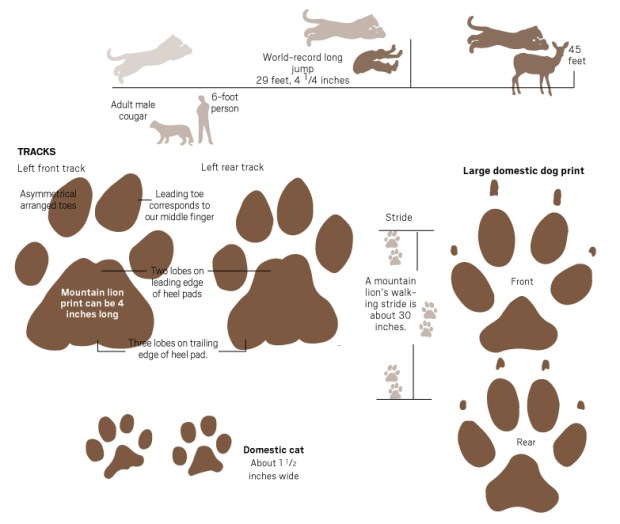- LIONHEARTED
A celebration of life for famed Southland mountain lion P-22 is being held Saturday, Feb. 4, honoring the cat who made Griffith Park his home and became the face of the endangered Southern California lion population. Here’s a look at the species that goes by several names – mountain lion, puma and cougar.
COUGAR FACTS
LIFESPAN A mountain lion typically lives about 12 years in the wild, and they can live up to 25 years in captivity.STATUS Not threatened or endangered, but protectedTOP SPEED 40 mphLEAP (highest) 16 feetMALES vs. FEMALES Males are about 35% bigger, measuring up to 9 feet from tip to tail and weighing up to 150 pounds. Males almost always travel alone; females sometimes travel with cubs.
 HUNTING They are most active at night but sometimes will hunt or travel in daylight. Ranges vary from 10 to 370 square miles, depending on opportunity and population. Adult cougars need to eat a deer about every 16 days, though a mother with three cubs will need a deer every nine days.FAMILY LIFE Cougars can breed year round, but most births occur between December and July. Females can begin breeding at age 2, and typically give birth to no more than four kittens in a litter. A newborn typically is about a foot long and weighs a pound. Males don’t take part in child rearing.
HUNTING They are most active at night but sometimes will hunt or travel in daylight. Ranges vary from 10 to 370 square miles, depending on opportunity and population. Adult cougars need to eat a deer about every 16 days, though a mother with three cubs will need a deer every nine days.FAMILY LIFE Cougars can breed year round, but most births occur between December and July. Females can begin breeding at age 2, and typically give birth to no more than four kittens in a litter. A newborn typically is about a foot long and weighs a pound. Males don’t take part in child rearing.
CATS EYESCougars have excellent night vision. Their peripheral vision is 287 degrees; a typical human’s peripheral vision is about 200 degrees.
SCAT Mountain lion waste may have the presence of bones, teeth and animal hair. It is usually about an inch and a quarter in diameter. They have been known to leave waste in areas to mark their kills.
WHEN YOU SEE THEM
HIKE IN GROUPS If you’re in mountain lion country, travel with others whenever possible. Make noise (to avoid sneaking up on the cougars) and keep children close at all times.STAY AWAY In the rare event that you see a cougar in the wild, do not approach it, particularly if you see that it is eating or with cubs.STAY CALM, TALK In the even less likely event that a mountain lion approaches you, do not run away. Talk firmly to the animal, but give it a way to run off. Most mountain lions want to avoid confrontation with humans.OTHER DON’TS Do not run. Do not turn your back.GET BIG Make yourself appear as big as possible; raise your arms. And pick up small children to prevent them from running.FIGHT BACK Throw rocks and sticks if necessary. Cougars have been driven away by prey that seems less easy to kill.
LEAP (longest) Cougars aren’t as fast as cheetahs or as strong as jaguars; they thrive because of their remarkable leaping ability. A cougar with a running start can fly 45 feet in a single leap.
Mountain lions are the biggest wildcats in North America. Their range extends from British Columbia to Central America. The species in our region rarely is seen east of the Mississippi.
More than half of California is mountain lion habitat, though many people are unaware of their natural behaviors and range. Mountain lions are solitary and generally avoid people.
Los Angeles is the only mega city in North America that has big cats living within the city limits.Learn more at savelacougars.org
A subspecies known as the Florida Panther, which lives in Florida, is critically endangered, with less than 100 in the wild.
Sources: Winston Vickers, UC Davis Wildlife Health Center; National Geographic, California Fish and Wildlife, Mountain Lion Foundation; The Nature Conservancy, savelacougars.org
Source: Orange County Register









Be First to Comment